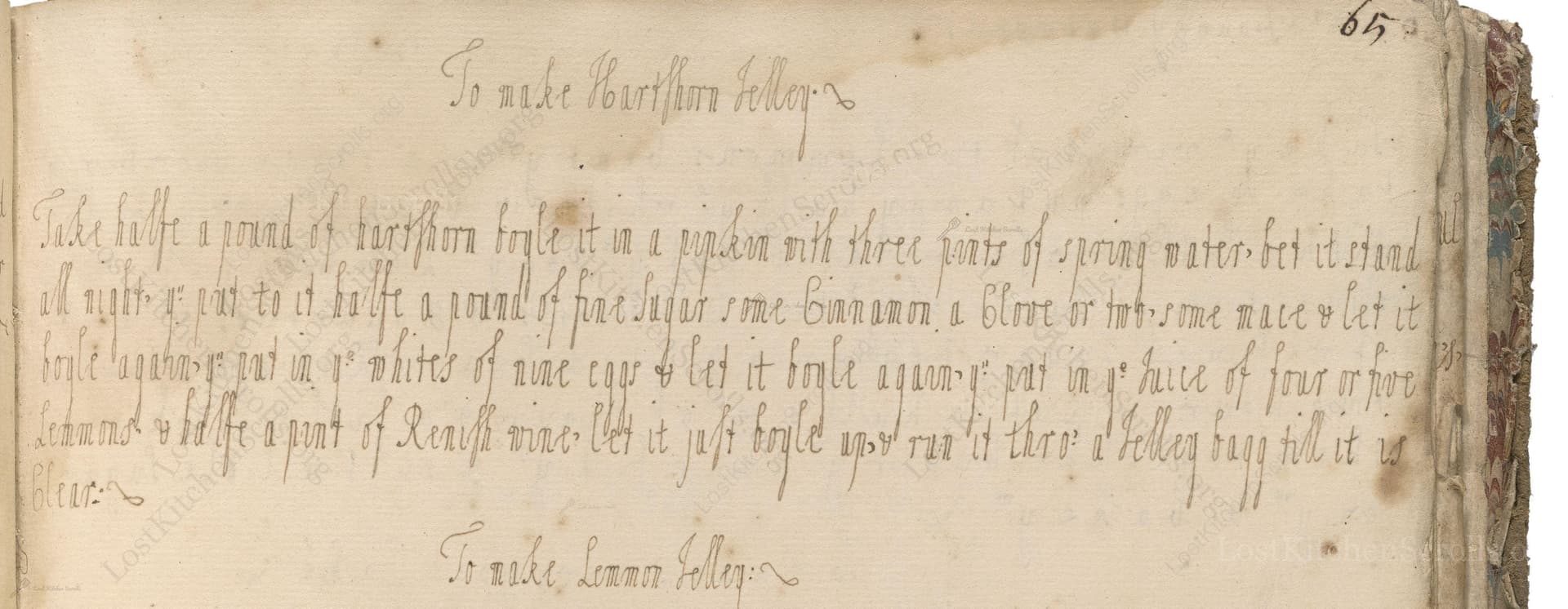To Make Hartshorn Jelley
From the treasured pages of Cookbook of Mary Puleston
Written by Mary Puleston

To Make Hartshorn Jelley
"Take halfe a pound of hartshorn boyle it in a pipkin with three pints of spring water. let it stand all night. yu put to it halfe a pound of fine Sugar some Cinnamon a blove or two. some mace & let it boyle againe. yu put in ye whites of nine eggs & let it boyle againe. yu put in ye juice of four or five lemmons. & halfe a pint of Renish wine. let it just boyle up & run it thro' a Jelley bagg till it is clear."
Note on the Original Text
The recipe is characteristic of eighteenth-century culinary prose—sparse on measurements, relying on the experienced cook's eye and hand. 'Pipkin' refers to a small clay pot, 'boyle' means to simmer or bring to a gentle boil, rather than a rolling boil. Spelling variants like 'blove' (for clove), 'Jelley' (for jelly), and 'Renish wine' (for Rhine or Riesling wine) reflect the more fluid orthography of the period. Ingredients are introduced as the method progresses, with implied knowledge about how and when to strain or clarify. The egg whites serve both as clarifiers and as an early form of fining agent, an ingenious technique that made jellies sparkling clear even before the advent of modern gelatin.

Title
Cookbook of Mary Puleston (1764)
You can also click the book image above to peruse the original tome
Writer
Mary Puleston
Era
1764
Publisher
Unknown
Background
A tantalizing compilation of 18th-century culinary wisdom, this collection artfully preserves the flavors, techniques, and charms of British cookery before 1764—inviting modern gourmets to savor a taste of history with every recipe.
Kindly made available by
Folger Shakespeare Library
This recipe is drawn from a manuscript compiled by Mary Puleston before 1764. The use of hartshorn—deer antler—is a hallmark of pre-industrial cookery, signaling a time before commercially available gelatin. Gentry and upper-class households prized such jellies for both their beauty and their supposed restorative powers. The blend of sugar, aromatic spices, citrus, and white wine speaks to the cosmopolitan palate of British households in the Georgian era, when imported goods and refined ingredients signaled status and refinement. Molten jelly—clear, gently flavored, and wobbling—was both a luxury and a marvel of culinary technology during Mary Puleston's lifetime.

The original preparation would have required a pipkin (a small earthenware pot), a hearth or open fire for slow simmering, and a jelly bag for straining—typically made from flannel or muslin, suspended from a wooden frame. Cooks would have also used knives for slicing the hartshorn and lemons, a mortar and pestle for bruising spices, and manual whisks or bundles of twigs for frothing egg whites. All labor was performed by hand and by firelight, adding both romance and challenge to the process. No refrigeration meant the jelly was enjoyed fresh, often alongside elaborate table displays at banquets.
Prep Time
10 mins
Cook Time
1 hr
Servings
8
We've done our best to adapt this historical recipe for modern kitchens, but some details may still need refinement. We warmly welcome feedback from fellow cooks and culinary historians — your insights support the entire community!
Ingredients
- 8 oz hartshorn (or substitute 1.4 oz powdered gelatin or 2.2 lb veal bones)
- 3 pints (6 cups) spring water
- 8 oz fine white sugar
- 1 cinnamon stick
- 1-2 whole cloves
- 1 small piece mace
- 9 egg whites
- Juice of 4-5 lemons (about 4-5 fl oz)
- 10 fl oz dry white wine (preferably Riesling)
Instructions
- Begin by taking 8 ounces of hartshorn (now best substituted with 1.4 ounces powdered gelatin or 2.2 pounds veal bones for a similar gelling effect) and placing it in a large saucepan with 3 pints (6 cups) of fresh spring water.
- Bring to a gentle simmer and then let it soak overnight to extract as much collagen as possible.
- The next day, add 8 ounces of fine white sugar, a stick of cinnamon, 1-2 cloves, and a small piece of mace.
- Bring the mixture back to a boil.
- Whisk the whites of 9 eggs until slightly frothy and stir them in, boiling the mixture again to clarify.
- Finish by adding the juice of 4-5 lemons (about 4-5 fl oz) and 10 fluid ounces of Riesling (a dry white wine).
- Let the mixture just come to a boil, then strain carefully through a jelly bag or several layers of muslin until the liquid is sparkling clear.
- Serve chilled, allowing it to set into a delicate jelly.
Estimated Calories
180 per serving
Cooking Estimates
It takes about 10 minutes to prepare the ingredients and set up. The cooking and simmering process takes around 1 hour, but you need to let it soak overnight for the best jelling. Each serving contains about 180 calories, and the recipe makes 8 servings.
As noted above, we have made our best effort to translate and adapt this historical recipe for modern kitchens, taking into account ingredients nowadays, cooking techniques, measurements, and so on. However, historical recipes often contain assumptions that require interpretation.
We'd love for anyone to help improve these adaptations. Community contributions are highly welcome. If you have suggestions, corrections, or cooking tips based on your experience with this recipe, please share them below.
Join the Discussion
Rate This Recipe
Dietary Preference
Main Ingredients
Culinary Technique
Occasions

Den Bockfisch In Einer Fleisch Suppen Zu Kochen
This recipe hails from a German manuscript cookbook compiled in 1696, a time whe...

Die Grieß Nudlen Zumachen
This recipe comes from a rather mysterious manuscript cookbook, penned anonymous...

Ein Boudain
This recipe comes from an anonymous German-language manuscript cookbook from 169...

Ein Gesaltzen Citroni
This recipe, dating from 1696, comes from an extensive anonymous German cookbook...
Browse our complete collection of time-honored recipes



